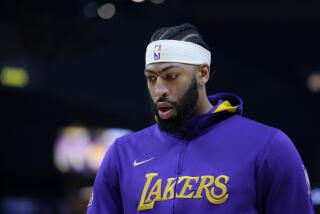Neurologists issue guidelines for concussions
- Share via
In a bid to set a new standard for amateur sports leagues’ treatment of brain injury, the American Academy of Neurology recommended Monday that any athlete suspected of suffering a concussion be removed from play immediately and be seen by a physician specially trained in the evaluation and treatment of brain trauma. Athletes should not return to play, the group added, until they have been cleared by a specialist.
The nation’s largest professional association of neurologists also recommended that a certified athletic trainer be present at all sporting events — including practices — at which athletes are at risk of concussion.
The new position statement, published Monday in the journal Neurology, comes just two weeks after the National Football League announced tough sanctions against the helmet-to-helmet tackles thought to carry the highest risk of brain injury.
The statement issued Monday is likely to have its greatest impact on the 4.1 million players in high school and youth football leagues, whose practice sessions and games are rarely monitored by professionals trained to detect and respond to brain trauma.
The explosion in youth sports over recent decades has put elementary and middle-school athletes at growing risk for concussion — the number of kids seeking emergency care for sports-related concussions more than doubled between 2000 and 2005, according to a study this summer in the journal Pediatrics. That increase was driven largely by a surge in such injuries among children between the ages of 8 and 14.
Those numbers are a source of rising concern, experts say, since research suggests that young brains are more vulnerable to a concussion’s effects and take longer to heal. The increasingly competitive culture of youth sports, paired with scant expert oversight, suggests that many young athletes are not removed from play quickly enough or long enough to protect their developing brains.
“Our mantra is ‘when in doubt, sit them out,’ ” said UCLA pediatric neurologist Christopher Giza, who helped draft the position statement. “We should be erring on the side of getting them out of a situation where they could be at risk of additional injury.”
Professional sports and college athletic programs typically have trainers and sports medicine specialists on hand during games and practices. Following new guidelines adopted by the National Federation of State High School Assns., high school programs this fall began removing athletes with a suspected concussion from play and allowing them to return only after they have been cleared by “an appropriate healthcare professional.”
By contrast, youth leagues generally rely on volunteers and parents to judge whether and how long an athlete should be removed from play. That can be a disaster, said youth sports safety activist Brooke DeLench, since coaches are often untrained and many parents fail to recognize or respond to concussion symptoms such as slurred speech, memory problems or disorientation in their children.
DeLench cited a survey released this summer that found parents of children who participated in sports woefully uninformed about the symptoms of concussion.
“I think everyone’s playing catch-up, including the American Academy of Neurology,” said DeLench, who founded MomsTeam after a neurologist urged her to remove one of her three sons from collision sports following his third sports-related concussion in 2000.
The American Academy of Neurology last issued practice guidelines on concussion in 1997. Since then, concussion research has exploded, fueled by growing activism among professional athletes and the U.S. military’s need to address brain injuries among combat veterans from Iraq and Afghanistan.
Brain trauma is more difficult to characterize, care for or recover from than experts had long believed, and as a result the 1997 guidelines are “out of date,” said Dr. Jeffrey Kutcher, director of the University of Michigan’s NeuroSport program and lead author of the academy’s statement. Kutcher and 11 other brain injury experts are rewriting those guidelines for an expected release in April 2012.







